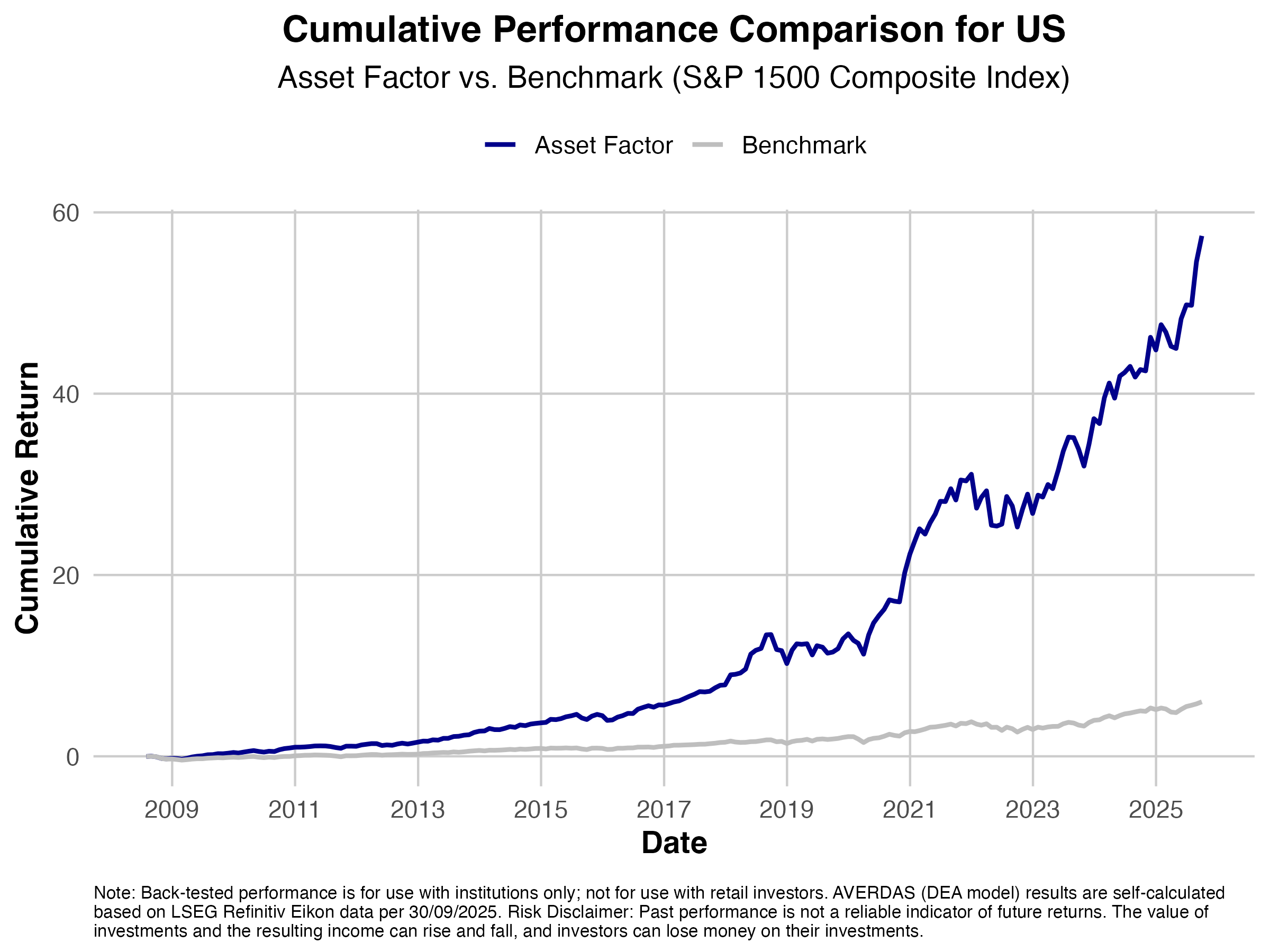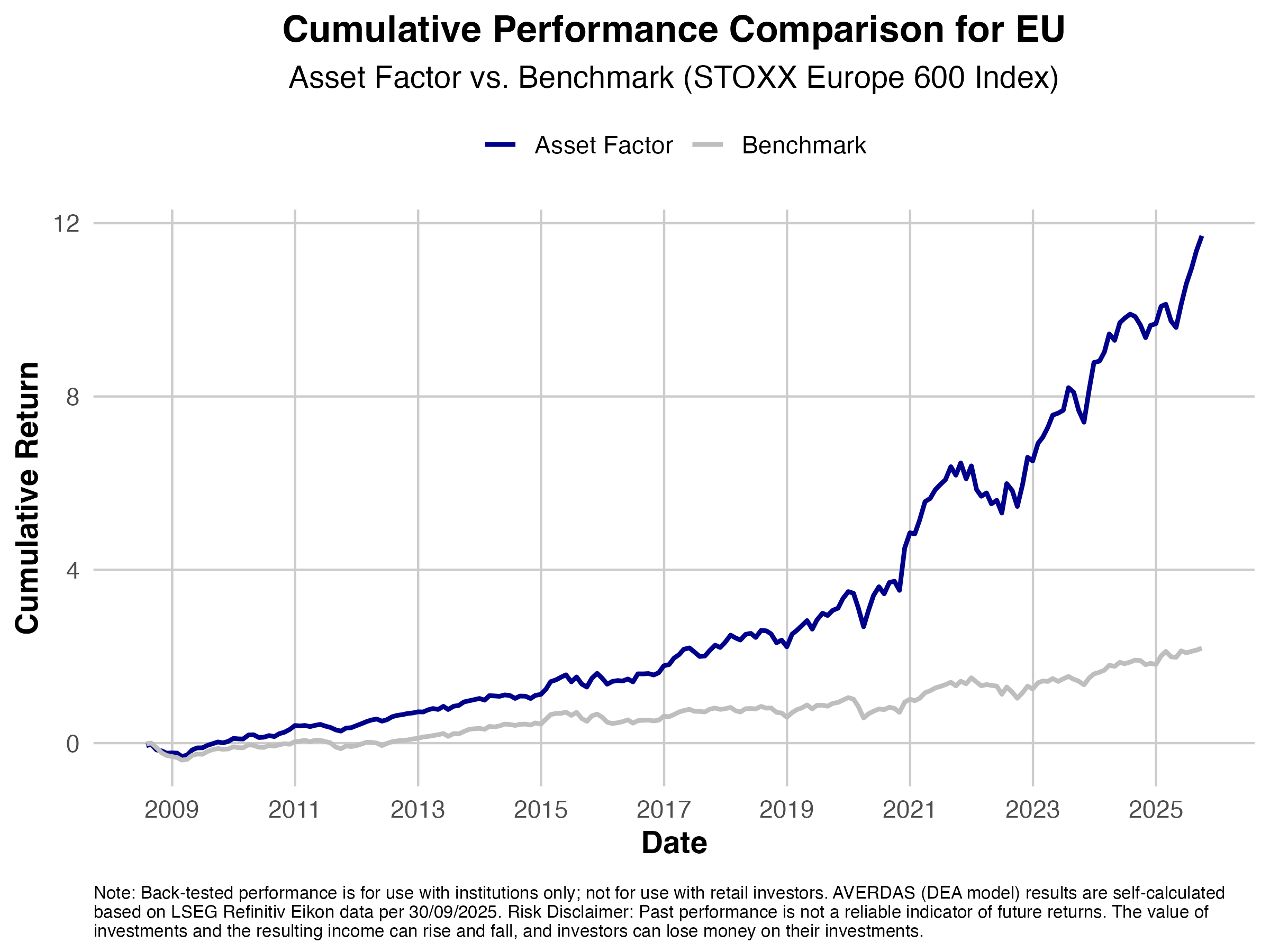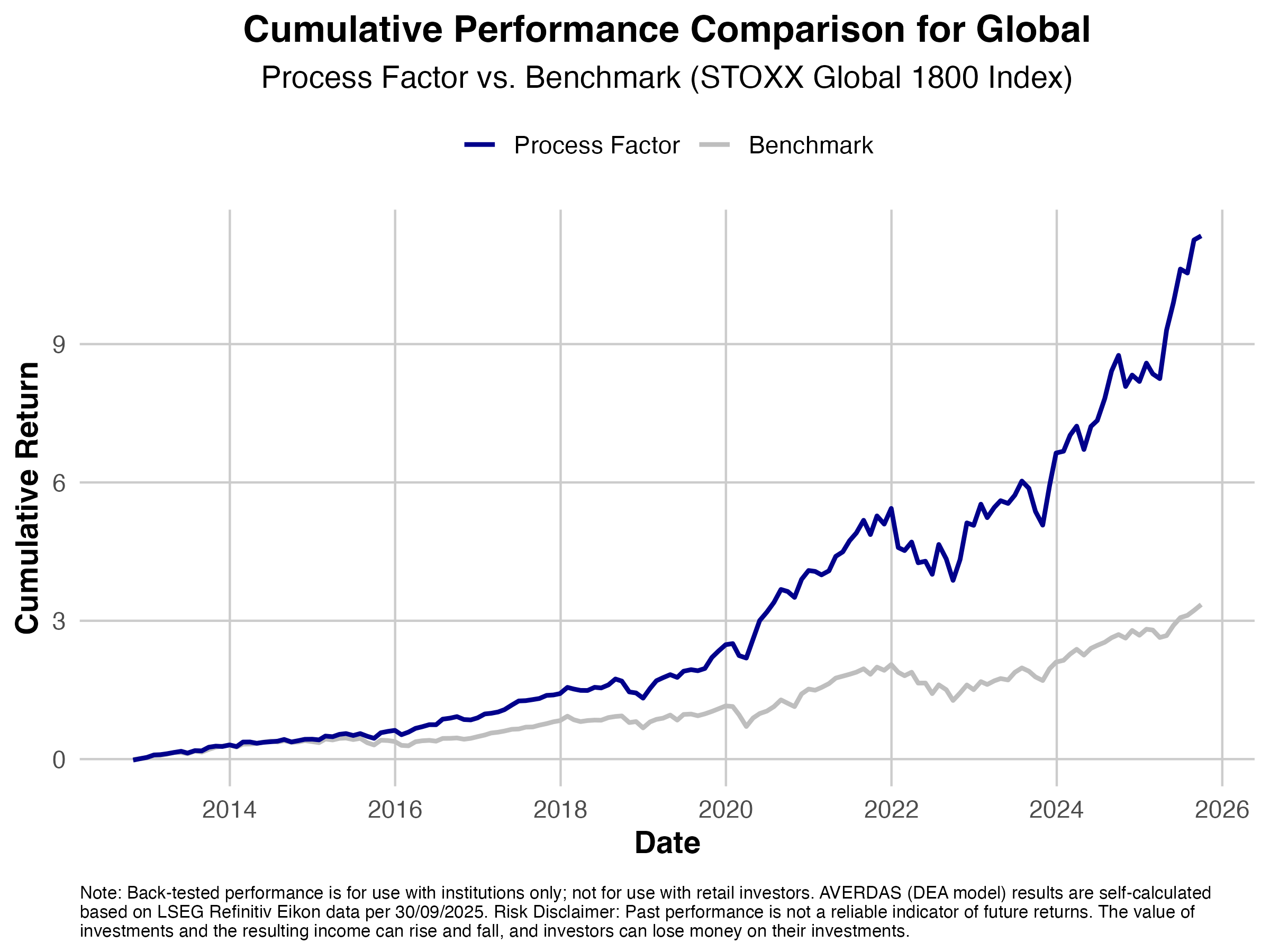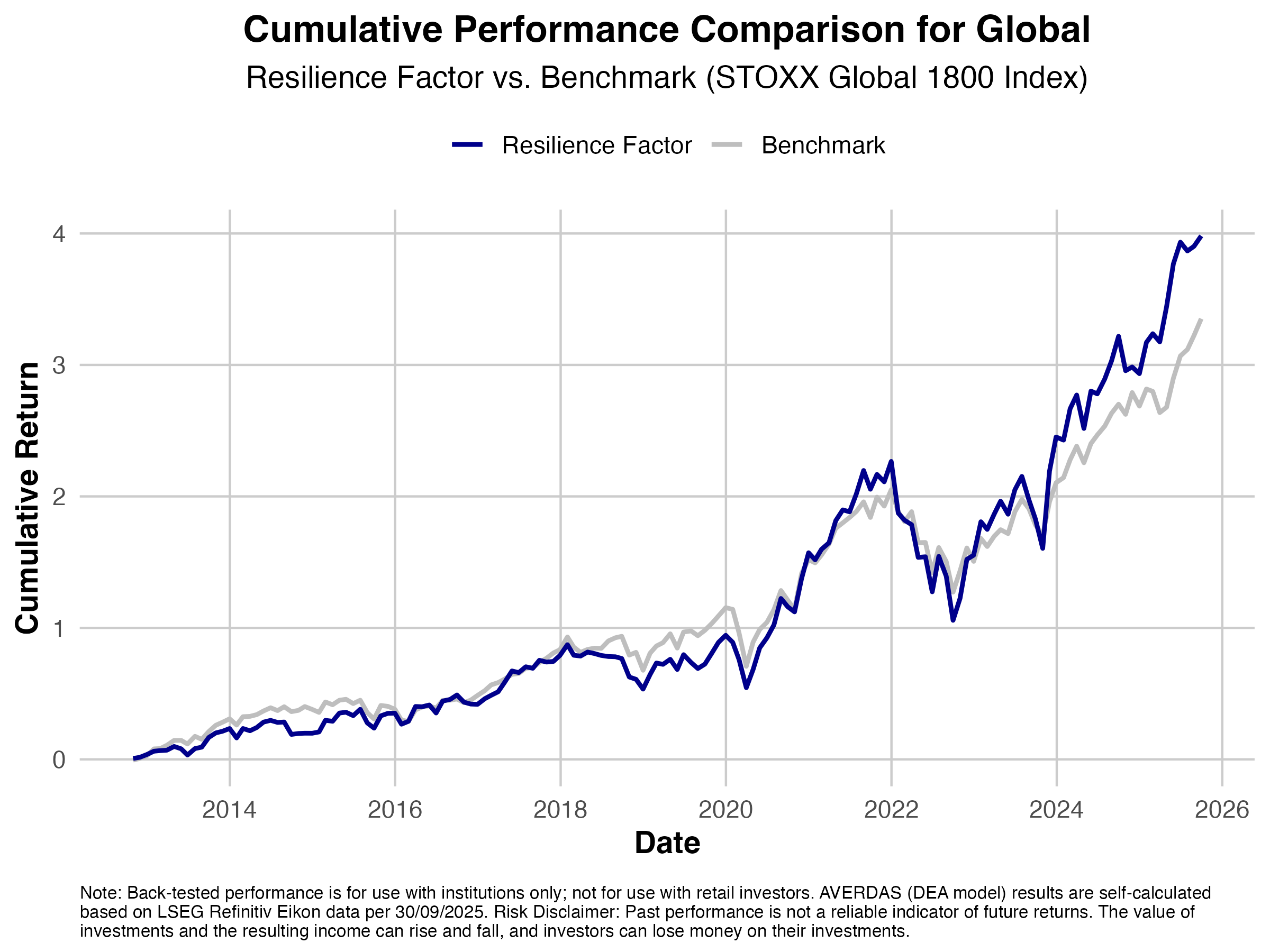Unlock Higher Returns with Data-Driven Factors on Productivity
Gain actionable insights and outperform benchmarks by leveraging comprehensive analysis of asset, process, resources, and resilience productivity factors.
Resource Factor
Make the Business
For sustainable business enabled by efficient use of resources.
How resource factor works?
Resource-efficient stocks tend to outperform resource-inefficient stocks over the long term. This is known as the resource-efficiency-score.
Why they outperform resource-ineffective stocks?
Organizations with a focus on reducing the consumption of resources have better stakeholder scores (i.e., ESG) and higher shareholder values, leading to higher returns.
Make the Business
Resource Factor

Resilience Factor
Stabilize Business
For stable business enabled by the ability to adapt quickly on a strategic and operational level.
How resilience factor works?
Resilient organizations better cope with disruptive events , “bounce back” faster to a pre disruption state, and “bounce forward” toward unprecedented futures.
Why they outperform resource-ineffective stocks?
Organizations having high resiliency anticipate, adapt and recover better from disruptive events on the systematic, strategic and operational level leading to higher stable returns.
Stabilize the Business
Resilience Factor

Process Factor
Run the Business
For profitability enabled by efficient use of operational capabilities.
How process factor works?
Process-efficient stocks tend to outperform process-inefficient stocks over the long run. This is known as the operating frontier.
Why they outperform process-ineffective stocks?
Organizations with better dynamic organizational capabilities are more efficient and aligned to the VUCA environment, leading to higher returns.
Run the Business
Process Factor

Asset Factor
Build the business
Long term growth enabled by effective use of assets like labor, capital and technologies.
How asset factor works?
Asset-effective stocks tend to outperform asset-ineffective stocks over the long term. This is known as the organizational production possibility frontier.
Why they outperform asset-ineffective stocks?
Organizations that fully utilize their assets will produce a higher quantity of goods more efficiently, leading to higher revenues.
Build the Business
Asset Factor

Multi Factor
After calculating each score, a multi-step procedure is applied to identify and select the best performing companies in terms of innovation-productivity, process-productivity, and resiliency. Step 2 builds on Step 1 by selecting the TOP 50 process-efficient companies from the TOP 100 innovation-efficient companies. In step 3 the TOP 20 performing resilient companies are matched with the TOP 50 of the identified companies after step 2. The remaining “spaces” are filled with the TOP 50 companies after step 2. This procedure ensures that the final selection embodies the best performing firms. This approach prevents over-reliance on any single factor while combining the benefits of growth, profitability, and stability.
Multi Factor
Productivity Factors in Investing
Data-Driven Asset Selection
Identification of Non-Linearities and Inefficiencies in the Market
.jpg)
Quantitative and Sophisticated Mathematical Model for Selection
.jpg)
Scientifically Proven Approach
.jpg)
Identification of Robust and Alpha-generating Productivity Leaders
.jpg)
Higher Returns Independent of Macro-Economic Cycles
.jpg)
Sector and Industry Independent
.jpg)
Size
Smaller, high-growth companies
Quality
Financially healthy companies
Momentum
Stocks with upward pricetrends
Carry
Income incentive to hold
riskier securities
Value
Stocks discounted relative
to their fundamentals
Minimum volatility
Stable, lower-risk
stocks
Quality
Financially healthy companies
Momentum
Stocks with upward pricetrends
Size
Smaller, high-growth companies
Similar Inputs Lead To Similar Results
Most investors use similar inputs in similar ways, leading to similiar results, including well-known factors such as quality, momentum, growth, value, dividends, low volatility, and size.
We at Averdas use data differently, apply different algorithms for different insights and build our new factors on productivity. With our approach we are able to identify productivity leaders that generate superior returns independent of macro-economic cycles.
Multi-Factor Indices: Combining Factors
While powerful individually, factors also can be used in combination to reflect market outlook and investment objectives. Some common factor combinations include:
Asset + Process
Asset + Resource
Asset + Resilience
Resource + Resilience
Process + Resource
Process + Resilience

Averdas Factor Indices Summary
In November, U.S. data indicated a slowdown in the economy, with private-sector employment experiencing a dip and manufacturing activity displaying additional signs of strain. Inflation did not move in a straight line, yet the overall tone of the data clearly supports the idea that the Federal Reserve is close to, or already at, the end of its tightening phase. Equity markets were mixed but steadied, as investors interpreted the moderation as manageable.
Conditions varied globally. Several advanced economies showed signs of losing momentum, while parts of the emerging-market universe, particularly in Asia, appeared somewhat more resilient than others. Market performance varied across regions, and sentiment improved slightly as commodity prices stabilized and policy expectations became clearer.
In Europe, activity showed a slight lift, largely due to firmer services, even as manufacturing remained weak and inflation came in higher than anticipated. Elevated costs and tight financial conditions continue to weigh on parts of the economy, but equities moved modestly higher, helped by the view that the ECB will keep its policy stance steady for the time being.
Source: Averdas Ag. Data as of 30. November 2025. Index performance based on total return (EUR/(USD)
Understanding the Full Scope of Productivity Factors
Asset Factor
Process Factor
Resilience Factor
Resource Factor
Multi-Factor
US
Asset Factor
US

.jpg)
Process Factor US

.jpg)
Resilience Factor US

.jpg)
Resource Factor US

.jpg)
Multi-Factor
US

.jpg)
Europe
Asset Factor Europe

.jpg)
Process Factor Europe

.jpg)
Resilience Factor Europe

.jpg)
Resource Factor Europe

.jpg)
Multi-Factor Europe

.jpg)
Global
Asset Factor Global

.jpg)
Process Factor Global

.jpg)
Resilience Factor Global

.jpg)
Resource Factor Global

.jpg)
Multi-Factor Global

.jpg)

.webp)
.avif)